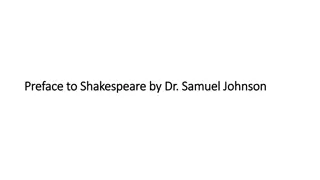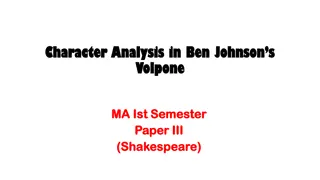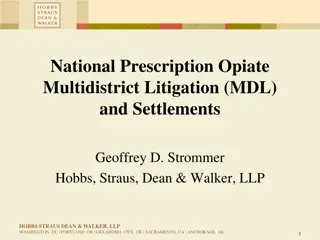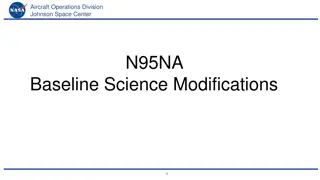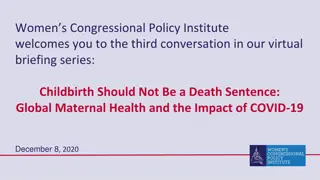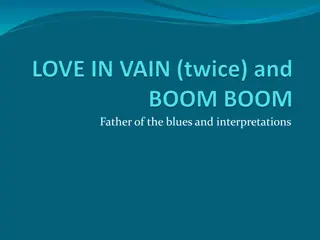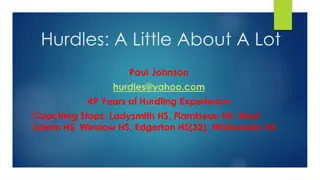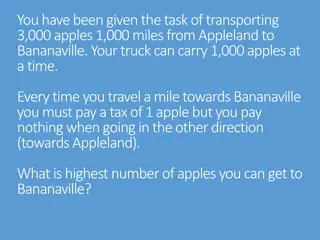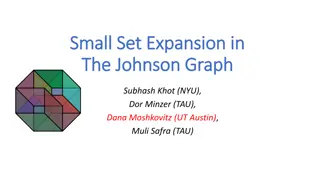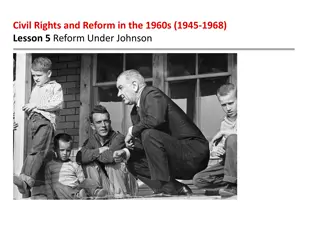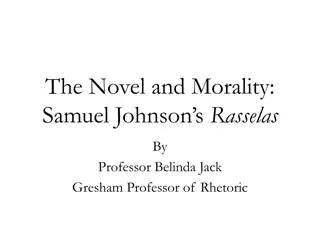
Agent Based Modeling of Animal Movement Mechanisms
Explore the complexities of animal movement mechanisms through agent-based modeling, spatial metrics, and population level distributions. This study delves into non-oriented and oriented movements, spatial memory, and dispersion patterns at the population level, aiming to unify diverse movement theories and evaluate dispersion patterns effectively.
Uploaded on | 0 Views
Download Presentation

Please find below an Image/Link to download the presentation.
The content on the website is provided AS IS for your information and personal use only. It may not be sold, licensed, or shared on other websites without obtaining consent from the author. If you encounter any issues during the download, it is possible that the publisher has removed the file from their server.
You are allowed to download the files provided on this website for personal or commercial use, subject to the condition that they are used lawfully. All files are the property of their respective owners.
The content on the website is provided AS IS for your information and personal use only. It may not be sold, licensed, or shared on other websites without obtaining consent from the author.
E N D
Presentation Transcript
+ Agent Based Modeling of Herds and Spatial Metrics for Animal Movement Beth Johnson johnsel@math.umd.edu Advisor: Dr. Bill Fagan Department of Biology bfagan@umd.edu
+ Background Background Background Landscape There are many different mechanisms that animals may use to direct movement Non-oriented random movement Oriented movement directed by a stimulus (visual observation of food) Spatial memory uses previous information, passed through individuals or generations Stage 1 Stage 2 RMI MCI Animals may use more than one or all three movement mechanisms PDI No current movement theory to unify all three mechanisms Testing Conclusion
+ Background Background Background Landscape There are three different population level distributions that animals exhibit Sedentary ranges individual occupies relatively small area compared to population range Migration regular movement to and from spatially disjoint ranges Nomadism does not follow regular temporal and spatial patterns Stage 1 Stage 2 RMI MCI Need a way to evaluate and qualify dispersion patterns at the population level that does not rely on an assumption of one of these three types of distributions PDI Testing Conclusion
+ Background Background Background Landscape Stage 1 Stage 2 RMI MCI PDI Testing Conclusion Mueller, Thomas, and William F. Fagan. "Search and navigation in dynamic environments from individual behaviors to population distributions." Oikos 117.5 (2008): 654-664.
+ Approach Evolve an Agent Based Model with ANN Background Background Landscape Stage 1 Evolve agents for landscape (stage 1) Create herd from best agent (stage 2) Fix Stage 2 landscape variability RMI MCI Determine spatial statistics PDI 1. Realized Movement Index 2. Population Dispersion Index 3. Movement Correlation Index Testing Gazelle Relocation Data Conclusion
+ Landscape Variability Background Landscape Landscape Patch size Stage 1 Stage 2 1 2 4 RMI MCI 75% PDI Predictability generations Testing 50% Conclusion
+ Landscape - Validation Background Landscape Landscape Landscape generation code run for 5000 generations, recording number of resources per patch (all landscape combinations) Stage 1 Stage 2 RMI MCI PDI Uniform Distribution of resources, except where patches of resources (red) or empty patches (blue) declared stable Testing Conclusion
+ Evolve agents for landscape Background Select random starting location Allow agent i to move 1 step across landscape Landscape Set landscape Stage 1 Stage 1 for 1:time steps Stage 2 Randomly initialize weights of agents for agents i < N Record resources, update landscape RMI MCI PDI Create 6 copies of that agent (with mutation + crossover) Find agent with most resources Randomly select 6 agents Testing Conclusion Until all agents selected
+ Agent Movement Background Mechanism Input Layer Hidden Layer Output Layer Landscape Bias Resource Uptake (total) 1 5 Stage 1 Stage 1 non-oriented Resource Uptake (last 8 steps) Search Effort Stage 2 2 4 oriented Resources in 8-cell neighborhood Current x location RMI spatial memory Current y location 3 6 Step counter MCI Inputs are scaled to be [-1,1], values at hidden and output nodes determined by the following, where weights are integers [-5,5] PDI InputNodes HiddenNodes Testing weightij weightjk exp InputNodei exp HiddenNodej i=1 HiddenNodej= j=1 OuputNodek= InputNodes HiddenNodes 1+exp weightij InputNodei 1+exp weightjk HiddenNodej Conclusion i=1 j=1 Mueller, Thomas, William F. Fagan, and Volker Grimm. "Integrating individual search and navigation behaviors in mechanistic movement models. Theoretical Ecology 4.3 (2011): 341-355.
+ Agent Movement - Validation Background Set test agents with specific genes (weights) and landscapes, with particular attention to edges and corners Landscape Stage 1 Stage 1 Node Value 0.267 0.484 0.055 Output Node 4 Output Node 5 Output Node 6 Stage 2 RMI MCI PDI Let agent choose direction 5000 times Create histogram Compare with known allowed directions 1. Testing 2. 3. Conclusion
+ Reproduction - Validation Background Landscape Set crossover and mutation probability to zero graph of efficiency vs. generation should have a sharp increase and then flatten after a few generations Stage 1 Stage 1 Stage 2 Average Resources Encountered Regular Mutation No Mutation Patch Size: 4x4 Predictability: 50% Generations: 300 RMI 0.5 Per Times Step 0.4 MCI Green: Mutation: 0% Crossover 0% 0.3 PDI 0.2 Blue: Mutation: 2% Crossover: 20% Testing 0.1 Conclusion 0 0 50 100 150 200 250 300 Generation
+ Stage 1 - Validation Background Landscape Compare overall trends (10 runs of each landscape) to results from Mueller et al. (100 runs of each landscape) Stage 1 Stage 1 Average of 10 Runs, 240 Agents Per Generation, 1000 Generations 0.8 P = 0 P = 0.25 P = 0.5 P = 0.75 P = 1 Stage 2 0.7 0.6 RMI 8x8 0.5 Efficiency MCI 0.4 4x4 0.3 PDI 0.2 2x2 1x1 0.1 Testing 0 100 200 300 400 500 600 700 800 900 1000 Generation Conclusion Mueller, Thomas, William F. Fagan, and Volker Grimm. "Integrating individual search and navigation behaviors in mechanistic movement models."Theoretical Ecology 4.3 (2011): 341-355.
+ Stage 1 - Timing Background Landscape Originally, all of Stage 1 was implemented in R, but the average time per generation (~16 seconds) was too slow to be feasible for the 10x1,000x20 = 200,000 generations to create plot on previous slide Stage 1 Stage 1 Stage 2 RMI Stage 1 was then implemented in MATLAB, with an average time per generation of ~2 seconds, allowing 10 runs of each landscape for 1000 generations in about 4.6 days MCI PDI Time is highly dependent on number of agents (240 in all simulations) Testing Conclusion
+ Stage 2 Background Landscape Keep agent with max resources and save landscape after 1000 generations Stage 1 Create 24 perfect copies of agent and generate landscape according to predictability + patch size (initial resource count in each cell is 24) Stage 2 Stage 2 RMI Agent movement rules are same as Stage 1, with the exception that agents cannot occupy the same cell MCI PDI Update each agent at a particular time step in a random order Testing Conclusion
+ Stage 2 - Validation Background Landscape Only large change from Stage 1 is new movement rule create more test cases focusing on when other agents occupy surrounding cells Stage 1 Stage 2 Stage 2 x Test Case 1 (Directions 5, 6) 0.7 RMI 0.6 MCI 0.5 0.4 Frequency PDI Node Value 0.267 0.484 0.055 0.3 Output Node 4 Output Node 5 Output Node 6 Testing 0.2 0.1 Conclusion 0 1 2 3 4 5 6 7 8 Directions Selected
+ Stage 2 Data Generated Background Landscape From Stage 2, 80 sets of simulated relocation data were generated - 20 landscapes, 4 data sets per landscape: Full data set: 24 agents, 150 (x,y) locations Half data set: 24 agents, 75 (x,y) locations, created by taking every other point from full data set Fifth data set: 24 agents, 30 (x,y) locations, created by taking every 5th data point from full data set Tenth data set: 24 agents, 15 (x,y) locations, created by taking every 10th data point from full data set Stage 1 Stage 2 Stage 2 RMI MCI PDI All data sets exported to .csv file with ID #, x, y Testing Conclusion
+ Stage 2 Data Generated Background Landscape 10 10 Stage 1 20 20 30 30 40 40 Stage 2 Stage 2 50 50 60 60 10 20 30 40 50 60 10 20 30 40 50 60 RMI Patch: 8x8 Predict: 100% Patch: 4x4 Predict: 100% MCI 10 10 20 20 PDI 30 30 40 40 Testing 50 50 60 60 10 20 30 40 50 60 10 20 30 40 50 60 Conclusion Patch: 4x4 Predict: 0% Patch: 4x4 Predict: 100%
+ Realized Mobility Index Background Landscape Describes how much of the annual population range an individual was using Stage 1 Stage 2 RMI is ratio of area of polygon for individual to the area of the polygon for the population RMI RMI MCI PDI RMIgreen=Area(green) Area(gray) Testing Conclusion
+ RMI - Validation Background Generate data sets of differing point sizes and compare with built in R function, chull Landscape Stage 1 All hulls were exactly the same Stage 2 RMI RMI MCI PDI Testing Conclusion R Core Team (2013). R: A language and environment for statistical computing. R Foundation for Statistical Computing, Vienna, Austria. URL http://www.R-project.org/.
+ RMI - Timing Background Landscape Theory says should find convex hull in nlog(H) time, where H is the number of points on the hull Stage 1 Stage 2 RMI RMI MCI PDI Testing Conclusion
+ Movement Correlation Index Background Landscape Assume movements are described by discrete time based Gaussian position jump process, N individuals, M steps Stage 1 Stage 2 Impose global mean ( x, y), global variance ( 2), and global correlation ( ) on all individuals RMI MCI MCI Use maximum likelihood to estimate parameters PDI Interested in position correlation ( ) Testing Conclusion Calabrese, Justin, Chris H. Fleming, Bill F. Fagan, Marin Rimmler, Petra Kaczensky, Peter Leimgruber, and Thomas Mueller. From the fish tank to the Gobi desert: A general, scalable approach to quantifying animal movement coordination. (2013)
+ Movement Correlation Index Background Landscape Want to maximize =-MTrlogCl-1 2 Stage 1 M [Dx(ti)-mx]TC-1[Dx(ti)-mx]+[Dy(ti)-my]TC-1[Dy(ti)-my] { } i=1 Stage 2 s r r r s r r r s RMI 1 1 C mx=mx my=my MCI MCI 1 1 PDI N x N N x 1 N x 1 Testing Closed form solution exists Conclusion Calabrese, Justin, Chris H. Fleming, Bill F. Fagan, Marin Rimmler, Petra Kaczensky, Peter Leimgruber, and Thomas Mueller. From the fish tank to the Gobi desert: A general, scalable approach to quantifying animal movement coordination. (2013)
+ Movement Correlation Index Background Landscape Closed form solution Stage 1 Stage 2 RMI MCI MCI PDI Testing Conclusion Calabrese, Justin, Chris H. Fleming, Bill F. Fagan, Marin Rimmler, Petra Kaczensky, Peter Leimgruber, and Thomas Mueller. From the fish tank to the Gobi desert: A general, scalable approach to quantifying animal movement coordination. (2013)
+ MCI - Validation Background Landscape Movement Correlation Index describes how much individual movements were correlated with other individuals movements Stage 1 Stage 2 Useful for consideration with other metrics, but the code is very simple (10 lines) RMI MCI MCI Validated by hand computation PDI Testing Conclusion
+ Population Dispersal Index Background PDI describes how clustered the individuals are at different spatial scales Landscape Stage 1 For each individual, compute the bivariate k function at distance s (expected value of points in Pattern 2 distance s from Pattern 1) Pattern 1 is the points for individual, # points m1 Pattern 2 is the points for entire population minus the individual, # points m2 Stage 2 RMI MCI PDI PDI Testing This function cycles through every point in pattern 1 and counts points in pattern 2 that are within distance s or less. Conclusion
+ Population Dispersal Index Background Landscape Stage 1 Stage 2 RMI MCI PDI PDI Testing Conclusion
+ Population Dispersal Index Background Landscape Stage 1 W(p2,p1) = .8 Stage 2 RMI If the point is outside distance s, do not count it. If it is inside distance s, count it, but account for edge effects. MCI W(p1, p2) = 1 PDI PDI W(pi,pj) is the fraction of the circumference of the circle (centered at pi crossing through pj) within the total population boundary. Testing Conclusion
+ PDI - Validation Background Landscape PDI was validated by comparison with the k12hat function in the R library Splancs Stage 1 Data sets of varying sizes were generated by drawing points from uniform distribution Stage 2 RMI MCI PDI PDI Testing Conclusion Rowlingson, Barry and Peter Diggle (2013). splancs: Spatial and Space-Time Point Pattern Analysis. R package version 2.01-34. http://CRAN.R-project.org/package=splancs
+ PDI - Timing Background Landscape PDI fully implemented in R was too slow to be feasible for simulation data sets (black circles) Stage 1 Final implementation was in C with an R wrapper (blue +) (approx 6000x faster) Stage 2 Timing PDI Function RMI 15 MCI Time (s) 10 PDI PDI 5 Testing + + + + + + ++ + + + + + + + + + + + + 0 5000 10000 15000 Conclusion Number of Points in Set 1 x Set 2
+ Testing Spatial Statistics Background Landscape 80 simulation data sets Stage 1 Gazelle data 36 individuals, x and y position data at various times (1 to 25 hour intervals) ranging from 50 to 978 days total Stage 2 RMI MCI PDI Testing Testing Conclusion
+ Testing RMI for Simulation Background RMI for 1x1 Patches Landscape 0.5 0 0.25 0.5 0.75 1 Stage 1 0.4 Stage 2 0.3 RMI RMI MCI 0.2 PDI 0.1 Testing Testing 0.0 Conclusion Full every 2nd every 5th every 10th
+ Testing RMI for Simulation Background RMI for 2x2 Patches Landscape 0.5 0 0.25 0.5 0.75 1 Stage 1 0.4 Stage 2 0.3 RMI RMI MCI 0.2 PDI 0.1 Testing Testing 0.0 Conclusion Full every 2nd every 5th every 10th
+ Testing RMI for Simulation Background RMI for 4x4 Patches Landscape 0.5 0 0.25 0.5 0.75 1 Stage 1 0.4 Stage 2 0.3 RMI RMI MCI 0.2 PDI 0.1 Testing Testing 0.0 Conclusion Full every 2nd every 5th every 10th
+ Testing RMI for Simulation Background RMI for 8x8 Patches Landscape 0.5 0 0.25 0.5 0.75 1 Stage 1 0.4 Stage 2 0.3 RMI RMI MCI 0.2 PDI 0.1 Testing Testing 0.0 Conclusion Full every 2nd every 5th every 10th
+ Testing RMI for Simulation Background Landscape 8x8 Patches, 25% 8x8 Patches, 50% Stage 1 10 10 Stage 2 20 20 RMI 30 30 MCI 40 40 50 50 PDI 60 60 Testing Testing 10 20 30 40 50 60 10 20 30 40 50 60 Conclusion
+ Testing RMI for Simulation Background RMI for Full Simulation Data Landscape Stage 1 0.3401 0.1477 0.2287 0.2447 1 Stage 2 0.75 0.304 0.1981 0.2033 0.155 RMI Predictability 0.5 0.4047 0.3311 0.148 0.1304 MCI 0.25 0.304 0.2027 0.216 0.3484 PDI Testing Testing 0.3259 0.176 0.2168 0.1699 0 Conclusion 1x1 2x2 3x3 4x4 Patch Size
+ Testing RMI for Simulation Background Landscape In general, RMI decreases slightly with larger sampling intervals Stage 1 Stage 2 As patch size decreased, RMI increased RMI Typically, migratory or nomadic animals would have high RMI, home range would have low RMI MCI PDI Testing Testing Conclusion
+ Testing MCI for Simulation Background Landscape MCI for All Simulation Data 0.1 Stage 1 0.0 Stage 2 0.1 RMI 0.2 MCI MCI 0.3 0 0.25 0.5 0.75 1 1x1 2x2 4x4 8x8 0.4 PDI 0.5 Testing Testing 0.6 Conclusion Full every 2nd every 5th every 10th
+ Testing MCI for Simulation Background Landscape Small patch sizes and short sampling intervals showed very small MCI Stage 1 Stage 2 Large patch sizes with long sampling intervals showed a large negative correlation Potentially due to random start location Potentially due to movement rules RMI MCI Typically, over long sampling intervals, migratory populations would have large positive correlation and in most other cases, correlation should be small PDI Testing Testing Conclusion
+ Testing PDI for Simulation Background PDI for 1x1 Patches Landscape 1500 Stage 1 0 0.25 0.5 0.75 1 Full 2nd 5th 10th 1250 Stage 2 1000 RMI PDI 750 MCI 500 PDI 250 Testing Testing 0 2 3 4 5 Conclusion Distance to Calculate PDI
+ Testing PDI for Simulation Background PDI for 1x1 Patches PDI for 2x2 Patches Landscape 1500 1500 0 0.25 0.5 0.75 1 Full 2nd 5th 10th Stage 1 1250 1250 Stage 2 1000 1000 RMI PDI 750 PDI 750 MCI 500 500 250 PDI 250 Testing Testing 0 0 2 3 4 5 2 3 4 5 Conclusion Distance to Calculate PDI Distance to Calculate PDI
+ Testing PDI for Simulation Background PDI for 1x1 Patches PDI for 4x4 Patches Landscape 1500 1500 0 0.25 0.5 0.75 1 Full 2nd 5th 10th Stage 1 1250 1250 Stage 2 1000 1000 RMI PDI 750 PDI 750 MCI 500 500 PDI 250 250 Testing Testing 0 0 2 3 4 5 2 3 4 5 Conclusion Distance to Calculate PDI Distance to Calculate PDI
+ Testing PDI for Simulation Background PDI for 1x1 Patches PDI for 8x8 Patches Landscape 1500 1500 0 0.25 0.5 0.75 1 Full 2nd 5th 10th Stage 1 1250 1250 Stage 2 1000 1000 RMI PDI 750 PDI 750 MCI 500 500 PDI 250 250 Testing Testing 0 0 2 3 4 5 2 3 4 5 Conclusion Distance to Calculate PDI Distance to Calculate PDI
+ Testing PDI for Simulation Background Landscape PDI values were very similar across differing sample intervals Stage 1 Stage 2 Increasing PDI (at all values of S) for increasing patch size RMI In general, higher predictability lead to larger PDI MCI PDI For home range, PDI should be small as animals typically occupy ranges that may not overlap, and migratory should have large PDI during migratory season Testing Testing Conclusion
+ Testing Gazelle Data Background Landscape As absolute position does not matter, scaled gazelle data to have similar scale as simulation Stage 1 Stage 2 Values similar to that of 1x1 patches for PDI and MCI, lower RMI than all simulations RMI Metric MCI RMI PDI (S=2) PDI (S=3) PDI (S=4) PDI (S=5) Value -0.1273 0.0751 0.0676 29.99 14.52 60.18 26.30 97.41 40.61 140.39 56.10 MCI PDI Testing Testing Conclusion
+ Conclusions Background Landscape RMI is fairly robust to sampling interval, but decreases with increasing interval, PDI very robust to sampling interval, MCI varies greatly with sampling interval Stage 1 Stage 2 RMI Agent based model does not sufficiently capture animal movement as to result in different population level patterns as seen in nature MCI PDI Testing Conclusion Conclusion
+ Further research? Background Landscape Larger map size Stage 1 Additional attractive/repulsive forces between animals in the herd Stage 2 RMI Periodic landscape regeneration MCI PDI Testing Conclusion Conclusion
+ Deliverables Background October Set up data structures for agents, code to initialize landscape and agents Landscape November Implement and validate genetic algorithm + neural networks Stage 1 Stage 2 December - Implement stage 1 (evolving agents) create mid year report and presentation RMI Late January - Implement stage 2 (herd of agents) [occurred in Feb/March] MCI Feb Implement RMI, PDI, and MCI March - Validate overall agent model and spatial metrics PDI April Test spatial metrics with gazelle data + simulation data Testing May Create final report + presentation, documentation + examples for spatial metrics code Conclusion Conclusion
+ References Background Calabrese, Justin, Chris H. Fleming, Bill F. Fagan, Marin Rimmler, Petra Kaczensky, Peter Leimgruber, and Thomas Mueller. From the fish tank to the Gobi desert: A general, scalable approach to quantifying animal movement coordination. (Unpublished, 2013) Landscape Stage 1 Kirkpatrick, David G., and Raimund Seidel. "The ultimate planar convex hull algorithm?." SIAM journal on computing 15.1 (1986): 287-299. Stage 2 Lotwick, H. W., and B. W. Silverman. "Methods for analysing spatial processes of several types of points." Journal of the Royal Statistical Society. Series B (Methodological) (1982): 406-413. Mueller, Thomas, William F. Fagan, and Volker Grimm. "Integrating individual search and navigation behaviors in mechanistic movement models."Theoretical Ecology 4.3 (2011): 341-355. RMI Mueller, Thomas, and William F. Fagan. "Search and navigation in dynamic environments from individual behaviors to population distributions." Oikos117.5 (2008): 654-664. MCI Mueller, Thomas, et al. "How landscape dynamics link individual to population level movement patterns: a multispecies comparison of ungulate relocation data." Global Ecology and Biogeography 20.5 (2011): 683-694. PDI R Core Team (2013). R: A language and environment for statistical computing. R Foundation for Statistical Computing, Vienna, Austria. URL http://www.R-project.org/. Testing Rowlingson, Barry and Peter Diggle (2013). splancs: Spatial and Space-Time Point Pattern Analysis. R package version 2.01-34. http://CRAN.R-project.org/package=splancs Conclusion

